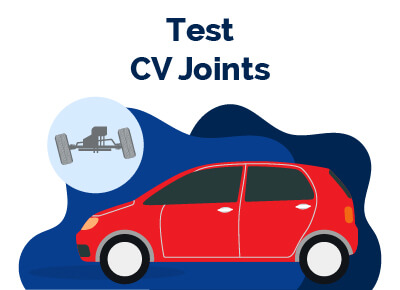How To Test CV Joints
July 23, 2023


Chris is Head of Content for FindTheBestCarPrice and is based out of Philadelphia, PA. As a seasoned automotive industry analyst and car enthusiast, he ensures the highest level of quality across all our content and curates our picks for the best deals each month.
Chris studied information systems and marketing at Drexel University and writes about a wide range of topics ranging from car buying tips to troubleshooting common mechanical issues.
When he’s not thinking about cars, he likes to stay in with his dog and make an “attempt” to finish a crossword puzzle (he’s not quite at the Saturday/Sunday level…yet). As a former cheesemonger, Chris still has a “sharp” passion for all things cheese, and his fridge is always loaded with it!
Chris also has a passion for things that go fast, and drones are no exception. He spends some of his time writing for Dronesourced.
The universal CV joints, also known as constant velocity joints, are present in all front-wheel drive automobile axles and many rear-wheel and four-wheel drive models.
These joints function analogously to universal joints, allowing for the independent turning and rotation of the front axle half-shafts.
CV joints are prone to failure for one of two reasons: either the rubber boot that safeguards the joint against road contaminants deteriorates or the joint wears out.
Almost without exception, the external joint adjacent to the wheel experiences more stress as the vehicle’s wheels turn and wear out more quickly than the internal joint. If the protective boot suffers damage, the joint usually malfunctions within 3,000 miles.
In this article, we will be looking at how to test CV joints, symptoms of bad CV joints, etc.
Table of Contents
How To Test CV Joints
It is easy to test your CVjoints. To successfully test your CV joints, take the following easy steps:
1. Inspect the rubber boots on the axle shafts adjacent to the wheel. If there are indications of harm or if the boot is coated in lubricant, it implies that the boot has been compromised.
2. Proceed to accelerate and decelerate at a rapid yet uniform pace while remaining attentive to any abrupt jerking or trembling emanating from the axles, all while keeping an ear open for any audible “clunking” sounds.
Turn the steering wheel to its fullest extent in one direction and then gradually increase acceleration, completing a tight circle.
Repeat this maneuver in the opposite direction. Any pronounced clicking, snapping, or popping sounds suggest that there is a faulty joint.
3. Elevate the automobile with the jack’s assistance and position it on the jack stands, ensuring that the stands do not impede the rotation of the axle by situating them along the vehicle’s frame.
Employ both hands to grasp each side of the CV joint and pivot the axle to and fro in opposing directions.
If an unusual amount of looseness or clicking sounds are discerned, it indicates a joint that requires replacement.
Symptoms of Bad CV Joints
There are specific indicators to be mindful of concerning the failure of CV joints. Presented below are the quintessential five symptoms that typically manifest when a CV joint has gone awry:
1. Bouncy Driving
Should your motor vehicle continue to exhibit a bouncing motion while traversing a level, paved road, it is probable that one or more of your CV joints may be malfunctioning.
You could visit an automotive service center specializing in transmission repair to ascertain the specific issue.
2. Knocking Sounds When Driving
A CV joint that has incurred wear and tear due to extensive usage will likely produce a distinct knocking sound, which could stem from the inner joint of a front-wheel drive automobile or the inner or outer joint of a rear-wheel drive car.
Additionally, knocking sounds may emanate from the differential gears.
To conduct a preliminary analysis of the joint issue, one may shift the vehicle into reverse gear and alternate between acceleration and deceleration while remaining attentive to the sound of any amplified knocking noises. Such noises would provide conclusive evidence of a CV joint that has failed.
3. Vibrations
An eroded or impaired CV joint will generate vibrations while the vehicle is in motion, as it cannot balance itself effectively during rotation.
The extent of the vibrations will amplify in direct proportion to the amount of acceleration applied.
When these vibrations exceed a certain threshold, they can jeopardize the driver’s control of the automobile and impede the overall riding experience for all passengers.
Consequently, the drive will become less comfortable and pose a greater risk to everyone in the car. The sole remedy for this situation is to replace the defective CV joint.
4. When Turning the Car Causes Loud Noises
If you hear clicking or popping when turning the steering wheel, it may indicate a worn or broken CV joint.
To test for this, follow these steps: Shift the gear into reverse, Turn the wheel to one side, and Depress the accelerator pedal. Be mindful of your surroundings as you will be maneuvering in a circle.
If there is a bad CV joint, the popping noises should increase in volume as you move in reverse in a circular motion. In this case, you may need to replace either the joint or the entire shaft assembly.
5. The Presence of Grease on the Tire Edges
If you observe grease near the edge of your tire, especially from a tear or minute crack, it may indicate the presence of a faulty CV joint.
In the case of a severely damaged joint, the rim and the wheel’s interior might show traces of darker-colored grease.
CV Joint Replacement Cost
A CV joint replacement costs between $95 and $210 for the part alone. In contrast, hiring a mechanic to perform the replacement job can range from $165 to $800, depending on whether it’s a double or single axle.
The parts cost for a double axle can be as high as $400, making the total replacement cost anywhere from $230 to $1180.
The cost may also vary depending on your vehicle’s make and model and the job’s complexity.
Since this is a significant service, your mechanic will conduct a comprehensive safety inspection of the boots and axles, especially if there is any grease on the tires.
Furthermore, replacing the axle and the CV joint may be necessary if there are any loud clicking sounds while turning.
CV Joint vs. CV Axle
Constant velocity (CV) joints are integral to a vehicle’s axle system. The axle system comprises two types of joints: inner and outer.
The axle system is part of the drive shaft that transfers engine torque from the differential or gearbox to the wheels. The number of CV axles in a vehicle’s driveshaft system varies by car type, ranging from two to four.
It is worth noting that front-wheel drive (FWD) automobiles have two CV axles on the front wheels.
The rear-wheel drive (RWD) vehicles, which possess independent rear suspension, contain a pair of CV axles in the rear wheels. All-wheel drive vehicles have four CV axles, with one axle per wheel.
CV joints and CV axles are made of different materials. A CV joint comprises a cage, balls, and an inner raceway housed in a rubber boot filled with lubricating grease.
The cage, balls, and inner raceway are all steel, while the rubber boot housing is rubber.
In contrast, a CV axle is constructed purely from SAE grade 41xx steel, also called “chrome-molybdenum steel” or “chrome-moly steel.” It can also be made of SAE grade 10xx steel, known as “carbon steel.”
Typically, CV joints last longer than CV axles. A CV joint can last between 70,000 to 130,000 miles before needing replacement. In contrast, a CV axle typically wears out before 100,000 miles.
How To Know When Your CV Axles Are Bad
Here is how to know when your CV Axles are bad.
1. When Your Joints Are Worn-Out
The symptoms of worn-out joints are easily recognizable. In the case of a problem with the inner joint, you will encounter vibration and noise during straight-line acceleration.
Conversely, if you hear a loud popping or clicking sound while making sharp turns, it is likely an outer joint problem associated with the CV axle.
It is important to note that acceleration problems can also result from issues with the transmission or motor mounts. If so, you must replace the mounts to fix the problem.
2. Leaking Boots
Visual inspection can quickly identify boot-related problems. To conduct an inspection, turn the wheels to all angles and search for signs of cracked or split rubber and grease on the inner or outer boot.
If the boot is damaged, grease will leak out, allowing debris to infiltrate, ultimately compromising the CV joint bearings.
Best Car Deals by Category
Frequently Asked Questions
How can I test my CV joints?
You can test your CV joints by performing a simple “CV joint test.” To do this, shift your car into reverse, turn the wheel to one side, and step on the gas pedal. Your CV joint is likely worn or broken if you hear clicking or popping sounds.
How do I know if my CV joint is bad?
Signs of a bad CV joint include clicking or popping noises when turning, vibration during acceleration, grease along the edge of your tire, and difficulty steering.
Can a bad CV joint cause a vibration while driving?
Yes, a bad CV joint can cause vibration while driving. If you notice vibrations while driving, your CV joints may be worn or damaged.
Can I still drive with a bad CV joint?
It’s not recommended to drive with a bad CV joint. A damaged CV joint can lead to a loss of control while driving and could cause further damage to your vehicle.
Posted in Car Buying Tips, Car Troubleshooting |




